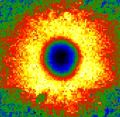Speaker
Description
Zintl compounds with a rare-earth element (Eu) have been known to present fascinating properties such as colossal magnetoresistance, thermoelectric phenomena, and magnetic topological states, which involves the valence of the rare-earth cations surrounded by polyanionic chains [1–3]. In this study, we achieved the growth of rare-earth Zintl phase shells on InAs nanowires by molecular beam epitaxy (MBE). Two different Zintl compounds which include Eu are grown depending on the polytypic structure of the core InAs nanowire; namely, wurtzite and zincblende InAs leading to the formation of Eu3In2As4 and Eu5In2As6, respectively. Novel topotaxial mutual cation exchange induces an in-situ vapor-solid conversion of binary III-V compounds into ternary Zintl ones in the MBE system. MBE growth parameters including substrate temperature and orientation, duration, and nanowire facet can significantly affect the crystal structure and atomic formation in the core-shell nanowires. Scanning electron microscopy (SEM) and high-resolution transmission electron microscopy (HR-TEM) were performed to investigate the morphology and structure of nanowire configurations in detail, respectively. High-angle annular dark-field scanning TEM (HAADF-STEM) and energy-dispersive X-ray spectroscopy (EDS) mapping provides extensive information regarding the atomic coordination and composition of the distinctive rare-earth Zintl structure. We used a magnetic properties measurement system (MPMS) and scanning superconducting quantum interference device (SQUID) microscopy to investigate the magnetic properties of the Zintl phase nanowires. Lastly band structure calculations were performed to determine the topological classification, depending on the magnetic order.
[1] S. M. Kauzlarich and J Jiang, Inorganic Chemistry in Focus III, John Wiley & Sons, 173–182 (2006).
[2] A. B. Child, S. Baranets and S. Boven, J. Solid State Chem. 278, 120889 (2019).
[3] Y. Xu, Z. Song, Z. Wang, H. Weng, and X. Dai, Phys. Rev. Lett. 122, 256402 (2019).

